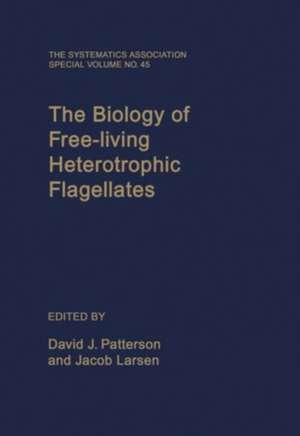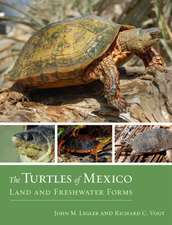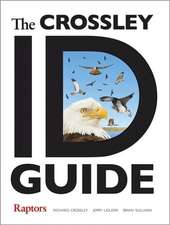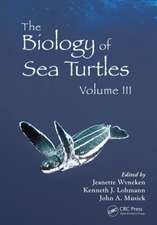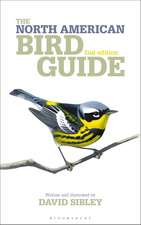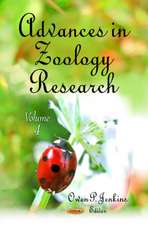The Biology of Free-living Heterotrophic Flagellates: Systematics Association Special Volumes, cartea 45
Editat de David J. Patterson, Jacob Larsenen Limba Engleză Hardback – 30 ian 1992
Preț: 839.70 lei
Preț vechi: 1268.01 lei
-34% Nou
Puncte Express: 1260
Preț estimativ în valută:
160.67€ • 167.36$ • 133.94£
160.67€ • 167.36$ • 133.94£
Carte tipărită la comandă
Livrare economică 18-24 martie
Preluare comenzi: 021 569.72.76
Specificații
ISBN-13: 9780198577478
ISBN-10: 0198577478
Pagini: 520
Ilustrații: numerous line figures,halftones,line illustrations
Dimensiuni: 163 x 238 x 35 mm
Greutate: 0.94 kg
Editura: OUP
Colecția OUP Oxford
Seria Systematics Association Special Volumes
Locul publicării:Oxford, United Kingdom
ISBN-10: 0198577478
Pagini: 520
Ilustrații: numerous line figures,halftones,line illustrations
Dimensiuni: 163 x 238 x 35 mm
Greutate: 0.94 kg
Editura: OUP
Colecția OUP Oxford
Seria Systematics Association Special Volumes
Locul publicării:Oxford, United Kingdom
Cuprins
David J. Patterson & Jacob Larsen: General introduction; Tom Fenchel: Flagellate design and function; Robert W. Sanders: Trophic strategies among heterotrophic flagellates; Ulrike-G. Berninger, David A. Caron, Robert W. Saunders, & Bland J. Finlay: Heterotrophic flagellates of planktonic communities: their characteristics and methods of study; Daniel M. Alongi: Flagellates of benthic communities: characteristics and methods of study; David A. Caron: Heterotrophic flagellates associated with sedimenting detritus; Wilhelm Foissner: Diversity and ecology of soil flagellates; T. Cavalier-Smith: Cell diversification in heterotrophic flagellates; G. Brugerolle: Cell organization in amitochondrial free-living heterotrophic flagellates; A.P. Mylnikov: Diversity of flagellates without mitochondria; Keith Vickerman: Organization of the bodonid flagellates; B.F. Zhukov: The diversity of bodonids; Richard E. Triemer & Mark A. Farmer: Ultrastructural organization of the heterotrophic euglenids and its evolutionary implications; Jacob Larsen & David J. Patterson: The diversity of heterotrophic euglenids; Paul Krugens & Robert E. Lee: Organization of cryptomonads; David R.A. Hill: Diversity of heterotrophic cryptomonads; Barry S.C. Leadbeater: Choanoflagellate organization with special reference to loricate taxa; Helge A. Thomsen & Kurt R. Buck: Choanoflagellate diversity with particular emphasis on the Acanthoecidae; Keith R. Roberts: The flagellar apparatus and cytoskeleton of dinoflagellates: organization and use in systematics; Malte Elbrachter: Food uptake mechanisms in phagotrophic dinoflagellates and classification; Jacob Larsen & Alain Sournia: The diversity of heterotrophic dinoflagellates; Ojvind Moestrup & Robert A. Andersen: Organization of heterotrophic heterokonts; H.R. Preisig, N. Vors & G. Hallfors: Diversity of heterotrophic heterokont flagellates; J.C. Green: Phagotrophy in prymnesiophyte flagellates; Stephen T. Moss: Thraustochytrids and other zoosporic marine fungi; David J. Patterson & Michael Zolffel: Heterotrophic flagellates of uncertain taxonomic position; Andrew J. Cowling: Free-living heterotrophic flagellates: methods of isolation and maintenance, including sources of strains in culture; Index.
Recenzii
'This is a very nice book indeed. The individual contributions are authoritative and up to date (references to 1990). The illustrations are clear throughout and an almost comprehensive index of organisms and subjects is included. The editors are to be commended for producing a symposium volume that stands out from the crowd in terms of organization, utility and timeless.'John R. Dolan, Marine Microbial Food Webs, 1992, 6(1)
'The chapters in this volume are clearly written and all are informative. The book is well produced. The bibliographies are very valuable, with reference to both older 'landmark' publications and recent studies, and there is a good, comprehensive index. The organisers/editors are to be congratulated for putting together such a timely volume of particularly great value to those of us who were not fortunate enough to attend the symposium.'M.A. Sleigh, European Journal of Protistology 29 (1993)
'The chapters in this volume are clearly written and all are informative. The book is well produced. The bibliographies are very valuable, with reference to both older 'landmark' publications and recent studies, and there is a good, comprehensive index. The organisers/editors are to be congratulated for putting together such a timely volume of particularly great value to those of us who were not fortunate enough to attend the symposium.'M.A. Sleigh, European Journal of Protistology 29 (1993)
